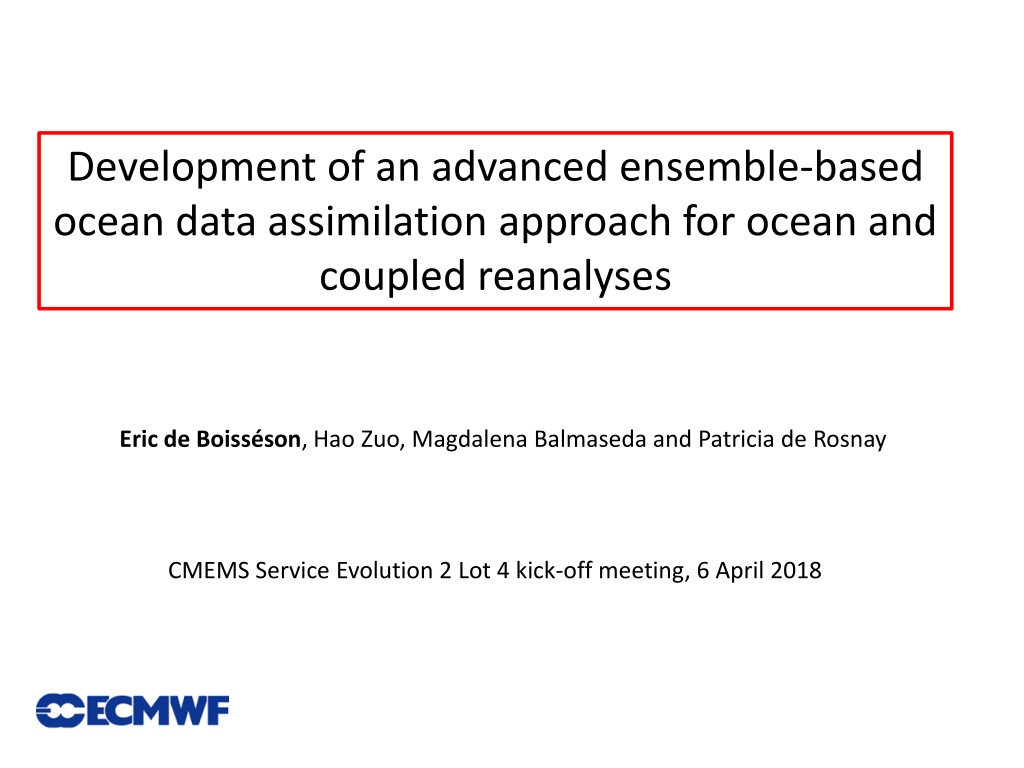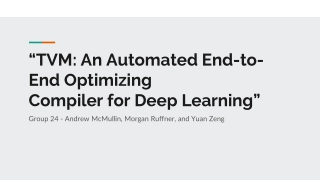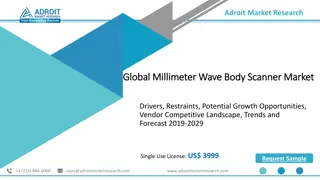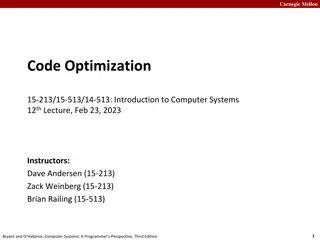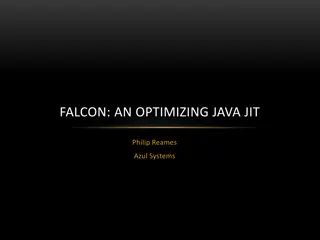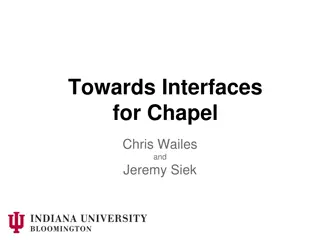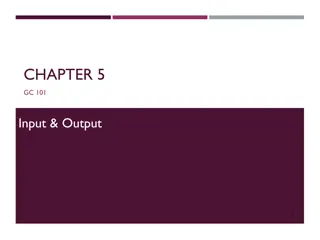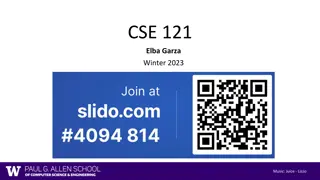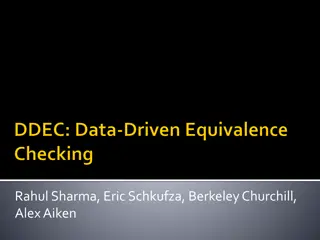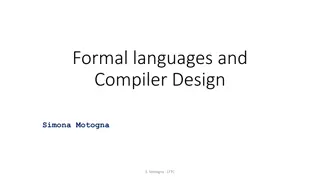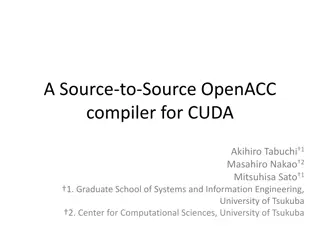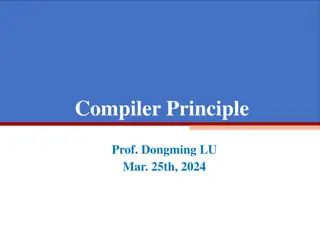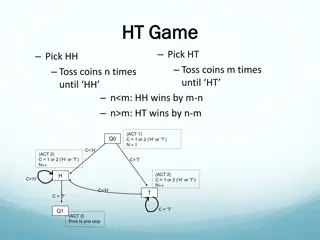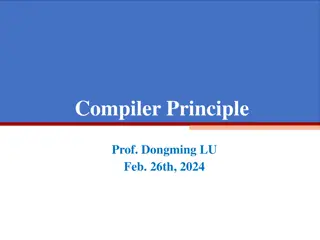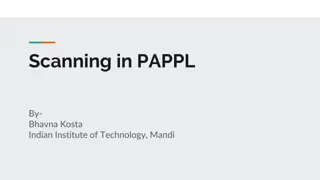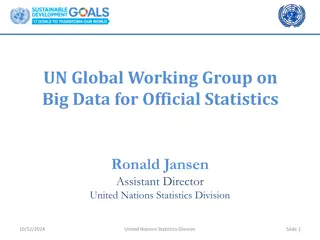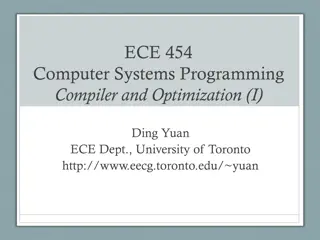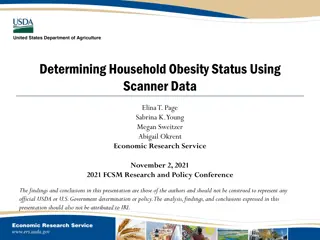Developing D Compiler in D-Scanner at DConf 2022
This project focuses on integrating the D language compiler within D-Scanner, aiming to enhance development tools in the ecosystem. Goals include improving dmd as a library and analyzing D source code efficiently. Explore the use of ASTBase and ASTCodegen for parsing and semantic analysis. Dive into the similarities among AST nodes and the implementation of Mixin templates in the project.
Uploaded on Mar 01, 2025 | 0 Views
Download Presentation

Please find below an Image/Link to download the presentation.
The content on the website is provided AS IS for your information and personal use only. It may not be sold, licensed, or shared on other websites without obtaining consent from the author.If you encounter any issues during the download, it is possible that the publisher has removed the file from their server.
You are allowed to download the files provided on this website for personal or commercial use, subject to the condition that they are used lawfully. All files are the property of their respective owners.
The content on the website is provided AS IS for your information and personal use only. It may not be sold, licensed, or shared on other websites without obtaining consent from the author.
E N D
Presentation Transcript
Development of an advanced ensemble-based ocean data assimilation approach for ocean and coupled reanalyses Eric de Boiss son, Hao Zuo, Magdalena Balmaseda and Patricia de Rosnay CMEMS Service Evolution 2 Lot 4 kick-off meeting, 6 April 2018
Context CMEMS Service Evolution 2 Lot 4 Section 4.7 of the CMEMS service evolution strategy: coupled ocean-atmosphere models with assimilative capability Advanced assimilation methods targeted to provide improved estimations of upper ocean properties consistent with sea-surface observations and air-sea fluxes
Context What we propose: A way to improve estimates of upper ocean properties is to improve the uncertainty estimate of the ocean state Develop a generic ensemble generation scheme for ocean analysis applicable in both ocean-only and coupled models. Optimize the use of the information from the ocean observing system Account for uncertainties of the surface variables and air-sea fluxes
Context Optimize the use of the information from the ocean observing system Major source of uncertainty: observation representativeness errors Mismatch between obs. and model resolutions Standard method: super-observation and thinning techniques But loss of information from the observing system Alternative: random perturbation + ensemble approach Better exploit the information from the obs. Uncertainty estimate
Context Optimize the use of the information from the ocean observing system: 2 examples 1. Assimilation of sea-ice observations from CMEMS OSTIA: Alternative: random selection within the thinning grid Ensemble spread uncertainty estimate Standard: 0.5x0.5 thinning Ensemble of analysis The random selection + ensemble approach provide estimate of the uncertainty and allow to further exploit the observing system
Context Optimize the use of the information from the ocean observing system: 2 examples 2. Assimilation of vertical T/S profiles: Vertical resolution of T/S profiles much higher than model grid Standard method: thinning Alternative: random selection within the thinning grid Ensemble approach The random selection + ensemble approach provide estimate of the uncertainty and allow to further exploit the information on the vertical axis
Context Account for uncertainties of the surface variables and air-sea fluxes Partially taken into account in current ocean analysis systems Example: current ECMWF ocean analysis uses monthly random perturbations on wind stress and SST based on differences between analyses How can we extend it? Other sources of uncertainty: bulk formulation parametrisations, sea-ice constraints and heat and freshwater fluxes A wider range of temporal scales (submonthly to monthly) Multivariate relationships In practice Use a wider variety of analysis datasets to provide structural and analysis uncertainties
Working plan System and input data: ORAS5 (CMEMS MFC GLO-RAN) Ocean only forced by atmospheric reanalysis NEMO 3.4.1 at 1/4 degree and 75 vertical levels LIM2 sea-ice model NEMOVAR DA CERA-SAT Coupled reanalysis system Ocean component similar to ORA-S5 Atmosphere ECMWF IFS 60km resolution and 137 levels 4D-Var DA and 10-member EDA system Input datasets In-situ T/S profiles SLA from CMEMS SL TAC SIC from CMEMS OSTIA SST (HadISST2, OSTIA)
Working plan ORAS5 CERA-SAT Surface forcing Observations Observations Bulk formula Obs operator Obs operator Coupled NEMO-IFS NEMO Model departures Model departures NEMOVAR 3DVAR FGAT NEMOVAR 3DVAR FGAT IFS 4DVAR Increment Increment Coupled NEMO-IFS NEMO Next cycle Next cycle ORAS5 and CERA-SAT: perturbations + ensemble approach = uncertainty estimate CERA-SAT: Uncertainty on surface forcing coming from atmos. EDA, flow dependent
Working plan WP1: development of the new perturbation scheme Task 1: Perturbations of ocean observations Task 2: Evaluation of the perturbation scheme for assimilated observations Task 3: Building a perturbation repository for surface forcing and surface variables Task 4: Evaluation of the perturbation scheme for surface forcing and surface variables Evaluation of the scheme in ORAS5: Ensemble spread diagnostics ECVs Against independent observations Against CMEMS GREP
Working plan WP 2: Application and evaluation in both ORAS5 and CERA-SAT systems Task 5: Application in both ocean-only and coupled assimilation systems Task 6: Evaluation in both ocean-only and coupled assimilation systems Evaluation of the scheme in ORAS5 and CERA-SAT: Coupled vs uncoupled, EDA vs static Ensemble spread diagnostics ECVs Against independent observations Against CMEMS GREP
Outcomes Section 4.7 of the CMEMS service evolution strategy: Advanced assimilation methods targeted to provide improved estimations of upper ocean properties consistent with sea-surface observations and air-sea fluxes. Main outcome: Generic ensemble generation scheme for ocean analysis applicable in both ocean-only and coupled models Optimize the use of the ocean observing system Account for the uncertainties from air-sea fluxes Potential impact of coupling on the upper ocean properties and their uncertainty Deliverables: Progress and final reports (+ code, possibly)
Outcomes Potential benefits on the CMEMS services: A better estimate of the ocean state consistent with air-sea fluxes and sea-surface observations An ensemble of ocean-only or ocean-atmosphere coupled IC for the CMEMS forecasting system with uncertainty information Feedback and potential improvement for different CMEMS TAC products (e.g. in-situ TAC and Sea-Level TAC) Improved monitoring of the ocean physical state, variability and change using an ensemble of reanalyses with uncertainty in climate signals Results and lessons learnt from this work will be transferred to CMEMS to help future CMEMS service update.
The team Eric de Boiss son (PI), ECMWF, coupled data assimilation (CDA) team Hao Zuo, ECMWF, CDA team Magdalena Balmaseda, ECMWF, Head of Predictability section Patricia de Rosnay, ECMWF, CDA team leader
Thank you for your attention Any question?
